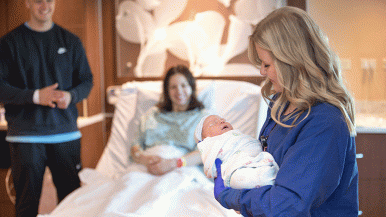Expectant parents in the western suburbs can choose a hospital for their baby’s birth that has earned the highest ranking in U.S. News & World Report’s 2025 list of Best Hospitals for Maternity Care. Rush Copley Medical Center in Aurora has received this “high performing” recognition for uncomplicated pregnancies every year since U.S. News began compiling the list four years ago.
The rating is the highest awarded by U.S. News and places Rush Copley among the top maternity providers in the nation.
“This recognition reflects the exceptional quality and compassionate care our dedicated team provides every day to our patients and their families,” said John Diederich, president and CEO of Rush Copley Medical Center. “This honor is a testament to the expertise, commitment and care of our entire team.”
Rush Copley provides a comprehensive range of birthing services, with a family birth center that offers labor and delivery, post-delivery and baby care, as well as the only alternative birthing suite in the Fox Valley area for those looking for a more natural labor and delivery. In addition, Rush Copley’s level III neonatal intensive care unit offers the highest level of care in the area, with expert providers ready to act when seconds matter most.
Best Hospitals for Maternity Care is an annual evaluation designed to assist expectant parents, in consultation with their prenatal care team, in making informed decisions about where to receive maternity care that best meets their needs.
In evaluating hospitals, U.S. News examines rates for C-section, complications, breast milk feeding, routine vaginal birth after cesarean delivery and episiotomy. To be recognized, hospitals must also meet federal criteria for “birthing-friendly” practices and track and report their outcomes for patients of different races and ethnicities.




